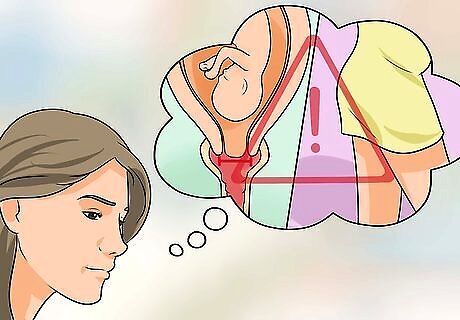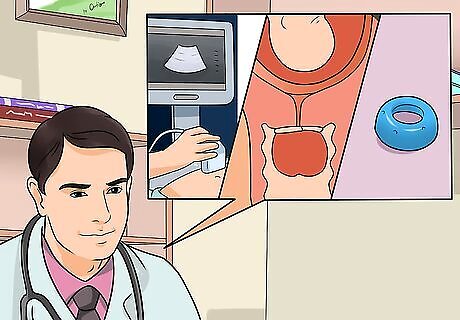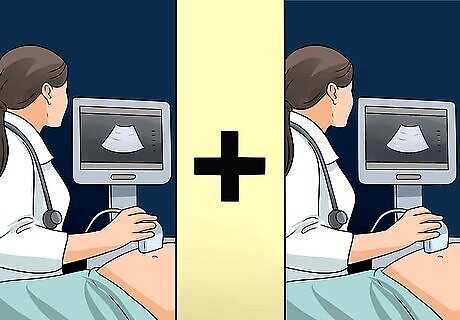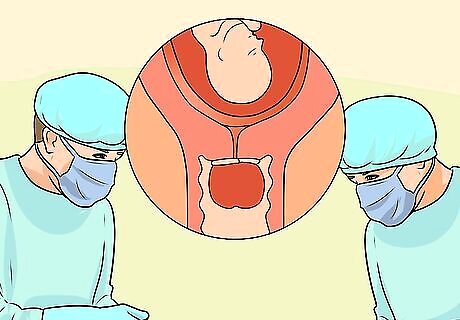
views
X
Trustworthy Source
Cleveland Clinic
Educational website from one of the world's leading hospitals
Go to source
Diagnosing an Incompetent Cervix

Know if you are at risk. Those who have previously had miscarriages in the second trimester (between weeks 14 and 27) are the most likely to have a cervical insufficiency, so it is important to disclose any prior pregnancy complications or miscarriages to your doctor. People are not diagnosed with an incompetent cervix until they have suffered one or more late miscarriages. Knowing about this condition in advance will allow your doctor to monitor your condition more closely from the beginning. This can result in earlier detection of a weak cervix, which leads to an increased chance of prolonging the delivery. Any surgery on the cervix also puts you at risk, including a D&C, cervical cone, or LEEP.

Be attentive to possible symptoms. Although it is possible for an incompetent cervix to be present without any outward symptoms, in some cases there may be warning signs. These would typically occur between 14 and 22 weeks of pregnancy and include backache, discharge or warm liquid felt within the vagina, and pelvic pressure.

Contact your OB/GYN immediately if you notice any of these symptoms. Although they may be completely unrelated to an incompetent cervix, it is always best to err on the side of caution and let the doctor do a complete exam to rule it out. This might include an ultrasound. Keep in mind that diagnoses of cervical insufficiency are based on one's past medical history of miscarriage during the second trimester. If you do have a cervical insufficiency, you have some medical options.
Undergoing Medical Treatment

Discuss treatment options with your doctor. He or she will be able to lay out the possible options—cerclage, a pessary, and bed rest—and tell you which ones would best for you. Keep in mind that a cerclage (suturing the cervix closed) is by far the most common treatment, and allows many people with previous histories of miscarriage to successfully carry a baby to term. A pessary, similar to the outer ring of a diaphragm, changes the angle of the cervix and reinforces it.

Consider with your doctor whether serial ultrasounds might be a good first step. With ultrasounds every two weeks during the second trimester of your pregnancy, the doctor can monitor the risk of an incompetent cervix. If he or she sees warning signs, then you can have a cerclage.

Undergo a minimal surgery to get a cerclage. Once you are diagnosed with incompetent cervix, your doctor will likely suggest a cerclage. A cerclage is a procedure in which a stitch is placed around the cervix and tightened to keep the cervix closed. There are five types of cerclage that can be performed, and your doctor will determine which type is best for your situation depending upon how far along you are in your pregnancy. A cerclage is usually removed near the end of pregnancy to permit normal delivery. Occasionally, depending on conditions that are present during the pregnancy, the cerclage will be left in place and the mother will undergo a cesarean section to deliver the baby.

Speak with your doctor about having a pessary put in place. A pessary is an apparatus that is positioned within the vagina to help raise up and reinforce the cervix. This may be used instead of, or in conjunction with a cerclage.

Ask whether bed rest or pelvic rest might help. Bed rest may be prescribed by your doctor for an incompetent cervix. Bed rest restrictions can vary from simply avoiding any heavy lifting or housework, to total bed rest where you must remain in a reclining position at all times, including for bathing and going to the bathroom. Talk to your doctor about whether or not some type of bed rest might be a good option for you. You may also need to abstain from sex during a period of bed and pelvic rest.
Taking Care of Yourself

Ensure you are getting adequate rest. Even if you are not prescribed bed rest, ensuring that you get adequate rest is important. Make sure that you get plenty of sleep and avoid overexerting yourself.

Ask your doctor about vigorous exercise. He or she might suggest you refrain from high-intensity workouts and from having sex. Because your cervix is weak, exercise can further exacerbate your condition.

Do your kegels. Kegel exercises strengthen your pelvic floor muscles. To ensure that you are doing them correctly, while you are urinating clench your muscles to stop the flow of urine, and then release to continue the flow; that is what exercising your kegels feels like. While is it not certain that kegels will prevent an incompetent cervix, they do have certain benefits including enhanced sexual pleasure, aiding in vaginal birth, help for incontinence and a quicker postpartum recovery.




















Comments
0 comment